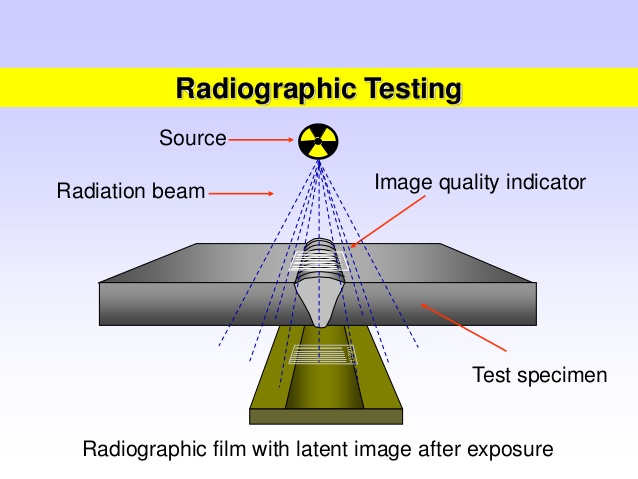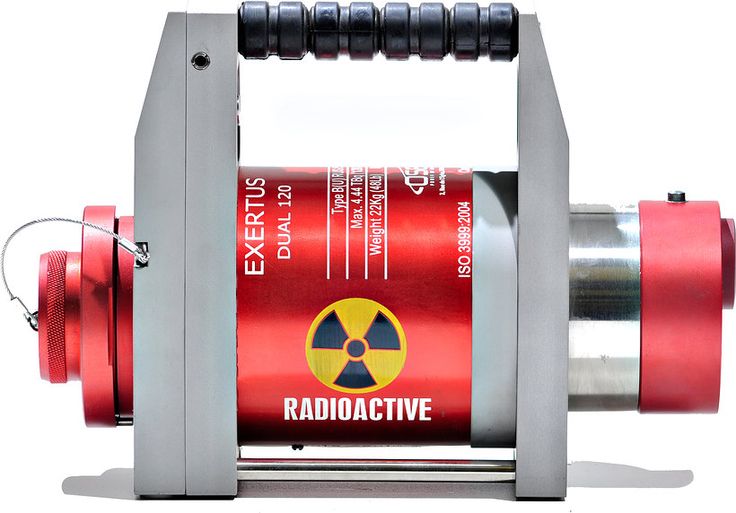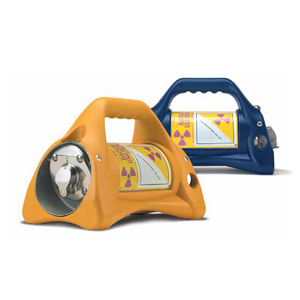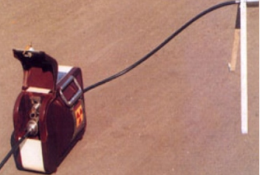PRINCIPLE OF RADIOGRAPHIC TESTING

Radiographic Testing (RT), or industrial radiography, is a nondestructive testing (NDT) method of inspecting materials for hidden flaws by using the ability of short wavelength electromagnetic radiation (high energy photons) to penetrate various materials.
The part to be tested is placed between the radiation source and a piece of film. The part will stop some of the radiation. Thicker and more dense area will allow less radiation to pass through. The property of the film will vary with the amount of radiation reaching the film through the test object. These differences in “absorption” can be recorded on film, or electronically.
The energy of the radiation affects its penetrating power. Higher energy radiation can penetrate thicker and denser materials. The radiation energy and/or exposure time must be controlled to properly image the region of interest.
Gamma rays are similar to X- Rays except that they have much shorter wavelength and differ in their origin. Gamma rays are emitted from the nucleus itself during the process of radioactivity. Gamma rays are produced by a radioisotope. A radioisotope has unstable nuclei that do not have enough binding energy to hold the nucleus together. The spontaneous breakdown of an atomic nucleus resulting in the release of energy and matter is known as radioactive decay.
Most of the radioactive material used in industrial radiography is artificially produced. This is done by subjecting stable material to a source of neutrons in a special nuclear reactor. This process is called activation. Two most commonly used gamma ray sources in industrial radiography are iridium 192 and cobalt 60.

Cobalt-60 is a preferred source for the radiography of steel thickness of about 75mm to 200 mm. We have world’s latest and sophisticated gamma ray projectors and proud to say that we are the only private agency in India having a maximum number of Cobalt -60 (TECH OPS) exposure devices.
COBALT-60 EXPOSURE DEVICES
- Sentry 110
- Co-60 Model 680
- Co-60 Model 741

Iridium -192 is used for radiography of steel thickness of about 6mm to 75 mm. We have Exposure devices (SPEC2T & TECH OPS) that are all imported and the latest.
IRIDIUM-192 EXPOSURE DEVICES
- DELTA-880 Model
- Tech – Ops – Model 660
- Roli – 2

Betatron is basically a combination of an electromagnet and a transformer designed to guide and accelerate electrons in a circular orbit to very high energies. The toroidal type of hot cathode high vacuum X-ray tube commonly used in betatron is capable of injecting and energizing electrons to many millions of volts before striking the target to produce X ray.
Betatron of this type have been constructed to generate X-rays at energies ranging from 15 to 100MeV.The average beam current is on the order of 1A to 3A.The Focal spot of the target is usually less than 1mm(0.04in) in diameter. Commercially available betatrons are capable of radiographing steel in the range of 5mm to 41 mm.
Varian Medical Systems (NYSE:VAR) is introducing a new, portable industrial linear accelerator—a high-energy X-ray generator for industrial applications—that is powerful enough to penetrate steel, concrete, or other materials yet small and light enough to be easily moved from place to place. The new Linatron® Xp can be integrated into imaging systems for pipeline testing, perimeter security, vehicle inspection, and many other infrastructure inspection and first responder applications.
Varian offers both liquid-cooled and air-cooled versions of the Linatron Xp depending on the environment or the application. “The liquid-cooled version is for what we call ‘high duty’ applications, where you need to keep the X-ray beam on for longer periods of time. It is designed to run continually without having to stop for it to cool down—for example, when performing routine inspection of oil or gas pipelines,” Drubka said. “The air-cooled version is designed to be used in short bursts, with thermal recovery periods in between—like when checking out a package in the context of a bomb threat.”
Designed for quick setup and teardown, the Linatron Xp weighs less than 250 pounds—roughly 1/10th the weight of a full-sized industrial linear accelerator. It fits into two cases that can each be moved by two people. It is easily integrated with Varian’s PaxScan 2530HE flat-panel digital image detector, or it can be built into systems using computed radiography or film for fast, real-time digital imaging.
“The Linatron Xp fills a void in the marketplace, because there is no other compact solution that operates at high energy—between 0.95 and 1.35 megavolts, which is right in between the energy of an X-ray tube and a full-sized industrial linear accelerator,” Drubka said. “It also operates at a wide range of temperatures and, unlike other technologies, utilizes no cobalt sources, so there’s no radioactive waste to dispose of or to possibly fall into the wrong hands and turn up in a dirty bomb.”
The Linatron Xp is manufactured in Varian’s ISO 9001 certified manufacturing facility. It is an extension of the technology behind the company’s proven high-energy Linatron accelerators for non-destructive testing, inspection, security, and cargo screening applications.
OVERVIEW:
The advent of Proposed Linac X-Ray Machine source of very high energy x-rays has opened up inspection possibilities in a wide range of environments. Applications have included such areas as Gas/Petrol pipelines, shutdown projects, huge castings, industrial equipment’s, nuclear waste containers, Thermal power plants, space launch systems and other thick section problems that cannot be imaged using with other existing NDT equipment’s and similar methods which is available with us.
ADVANTAGES OF THE PROPOSED LINAC “M3A DUAL ENERGY X-RAY DEVICE”:-
HIGH OUTPUT
The output of Proposed Linac “M3A Dual Energy X-ray device” can carry out radiography from 31 mm to 230mm thickness. This gives the user great latitude for developing exactly the system to meet his needs without the large price differences normally associated with an increase in output.
THICK SECTION PENETRATION
As with output, the Linac “M3A Dual Energy X-ray device” system can match the penetration capability of fixed units in all respects. An important thing to remember is that these energies have never been available in the field before the appearance of these accelerators. That means otherwise un-inspectable areas can now be considered as candidates for NDE examination. For
instance, up to 230mm pre-stressed Huge Castings with defect indications can now be examined.
SHORT EXPOSURE TIMES
The very short exposure times, most commonly a few minutes or less, characteristic of accelerators make them much less sensitive to effects such as vibration or ambient radioactivity that limit other work. Radiation perimeter control is likewise made much easier and safer because of the very short exposure times. Further compare to the existing machines of cobalt 60 source device, the exposure time will be reduced enormously, for example if we take radiograph 180mm thick with cobalt 60 source device, to take for 1 exposure, it consumes 4 hours exposure time, by using for the same parameter with Linac X-ray machine, it will be 8 minutes per exposure.
IMAGE QUALITY/RESOLUTION
In addition to the shorter exposure times and high energy/output, this can give a higher sensitivity and finer film resolutions other than existing technology which is available with us, which will help us to interpretation more rapidly.
NO DECAY FACTOR FREQUENTLY
Frequently we are sending IR 192 device and Co-60 device to Board of Radiation and Isotope Technology to refill the powerful source, in this connection Co-60 device having decay factor frequently. In this technology there are no decay factors.
CONCLUSIONS
The experience of Caltrans has shown the portable linear accelerator to be a safe and effective method for radiographic inspection of a wide and huge shutdown projects. The consideration of this technology is recommended for those faced with the examination of large thick section structures that would otherwise defy analysis.
PRODUCTION RELATED ADVANTAGES
Now a day, NDT is mandatory on industrial components and similar shutdown projects, and its increasing customer base. The most of major customer’s demand for instant results, the proposed Linac Machine will help us to furnish the same within stipulated time, where it is difficultly to serve the customer needs with existing technology.
At present this technology is not yet implemented by any NDT industries in South India, henceforth; the major customer base will be increased as well as sales. The export customers are orally demanding to implement this technology. The additional benefits of the Linac machine like shorter exposure times and high energy/output, this can provide a higher sale.

